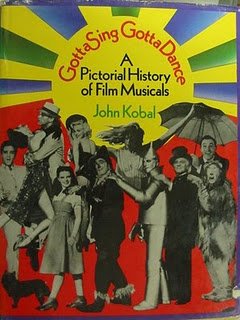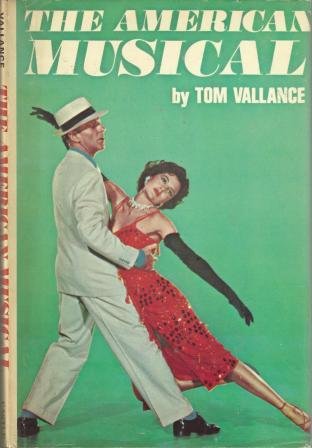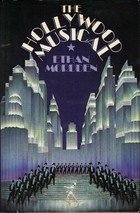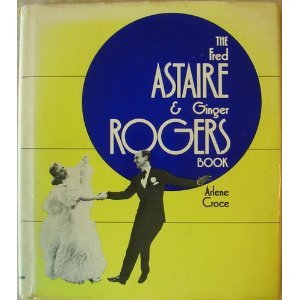The Print Musical
I’m a refugee of the print musical—a musical of the heart and mind.
To explain what I mean, I have to take you back to a time when there was no YouTube, no DVD, no VHS, no cable. The year was 1974 and I was 7. One spring weekend, my Aunt Ethel and I rode the RTD to the revival house on Wilshire to see a movie called A Damsel in Distress.
The movie stars Joan Fontaine as Lady Alyce Marshmorton, holed up in a castle on the foggy moors. Fred Astaire is the American entertainer Jerry Halliday (what a name) who comes to rescue her, accompanied by his wisecracking press agents, George Burns & Gracie Allen. The whole thing peaks with an amusement park number that includes tap dancing in front of funhouse mirrors and high romance in the Tunnel of Love.
Needless to say, 7-year-old me was freaked out of his ever-loving mind. I mean, I was dumbstruck.
But in 1974, what could I do about it?
In those days, even if you had the will power (or the permission) to stay up late, you might catch an old musical on KTLA’s Late, Late, Late Show, but you couldn’t bank on it. Catalogs traded Super 8s for home projection, usually silent, usually seven rickety minutes long. You might browse the alphabetized stills at Larry Edmunds—but those aisles were dark and forbidding, shoulder to shoulder with old haggard kooks and desperate-looking autograph hounds. Naturally, I had no idea that the movie was based on a novel by PD Wodehouse. There was just nothing to be done. I was like a person who has a glimpse of paradise for 98 swift minutes and then is told to wait at a bus stop for all eternity.
A few weeks later, though, tagging along with my mom to Pickwick Books on Hollywood Boulevard, I wandered into the then quite humble “Cinema” section, and I went browsing the stacks, dwarfed by strange oversized titles like Gotta Sing Gotta Dance and Hollywood Panorama[1]. I reached to pull them down and opened them up as an archaeologist might unroll the Dead Sea Scrolls. The black and white stills shone like shaded pearls over quotes of strange and dizzying lyrics—this one about a dance called The Continental:
“It’s like a fever,
it’s like a plague,
it swept all Europe,
from Moscow to the Hague.”[2]
In a frenzy, I bought Arlene Croce’s The Fred Astaire & Ginger Rogers Book (Galahad Books, NYC 1972) only to discover, to my disturbed kiddie shock, that it didn’t include A Damsel in Distress! That made sense, since Ginger wasn’t in that movie, but this square yellow hardcover did include a two-way flip book in the corner—Fred and Ginger dancing as fast as your thumb could ride, in both directions. I think I flipped those dances 50,000 times.
The other thing the book had was Croce’s retelling of the stories of each flick, panning out their sometimes microscopic differences. This, on Swing Time:
It’s a world of nighttime frolics...but it’s also a middle-class, workaday, American world. It is top hats and empty pockets: Fred (John “Lucky” Garnett) as a Depression dandy hopping a freight car, Ginger being sung to with soap in her hair...If you put Top Hat in a glass ball like a paperweight and turned it upside down, it would be Swing Time.
Croce (who founded Ballet Review and was the premier dance critic at the New Yorker for many years) also described every single number, writing with the unbroken cascade of a dancer. Here’s Croce on “Waltz in Swing Time”:
Here they come again...a wide, white stream flowing in agile cross-rhythms, flowing without pause through so many intricacies and surprises, so many acts of mutual gallantry. It is pure white...and it just flies—it’s the brio of romance.
A few weeks later, for my 8th bday, I was given a French double LP to supplement this hinky new obsession. This too included summaries, en francais. I didn’t read French but my dad spoke it, and anybody could kind of get the gist: Dans une rue de New York, le danseur Lucky recontre une jeune et jolie femme, professeur de danse Penny Carol. Between these two loony approximations—the crackly double LP and the black and white book—I plunged into a world of musicals that, as far as I knew, I would never actually see!
At the time, it never occurred to me that I wasn’t getting “the real thing”. I simply answered the call to reconstruct the magic in my head, and got lost in a labyrinth based solely on fractured evidence. In fact—and this may constitute an actual point, people!—the reconstruction was certainly much more real to me than any movie could ever be. It was a reality in which I was a total participant.
Now—I would never want to discourage someone from seeing the magic musicals that inspired these sometimes clunky volumes, but nevertheless these Books About Musicals do illustrate, ahem, the peculiar way we bond to books, all books, as nothing else. Later in life, stumbling through the world of literature proper, I found that a book—especially one found accidentally—has the power to override anything you go looking for. It doesn’t even need to come with a flipbook!
Someone leaves a paperback of Dostoyevsky’s The Gambler in a hotel reading basket. The “hero”, Alexei Ivanovich, is a man not totally unlike Astaire’s Jerry Halliday or "Lucky" Garnett. He’s impulsive, maybe too susceptible to falling hard in love, light on his feet where he most requires gravity. You pick up this paperback and it’s like you accidentally kicked a beehive. You can’t believe this…thing—when closed, laying in the basket—managed to hide such energies. For Alexei is not “a fictional character,” of course not—he’s you, “the gambler in your head,” making his way through an imagined casino, roulette wheels spinning.
Now…you can turn The Gambler into a smash-hit movie and transform that movie into a song-filled Broadway show and a star-studded musical (Gamblin’!). Then you can upload 326 YouTubes from the musical and GIF the bejeezus out of them — why not.
But you can never replace that foggy, sublime secret pact you made when there was a gap—a negative space, a holy space—when all you had was shrapnel, a handful of lyrics and the music of the printed page.
Footnotes:
[1] Later I would come to learn that these one-off volumes about the golden age of musicals (and other show biz books like Hollywood Babylon and The Parade’s Gone By) were a “thing” in the ‘70s, part of Hollywood’s growing self-consciousness about its own legacy. Sure enough, that very summer, MGM answered the call and released That’s Entertainment!
[2] From “The Continental” in The Gay Divorcee, first-ever winner of Academy Award for Best Original Song. Words by Herb Magidson, music by Con Conrad.








